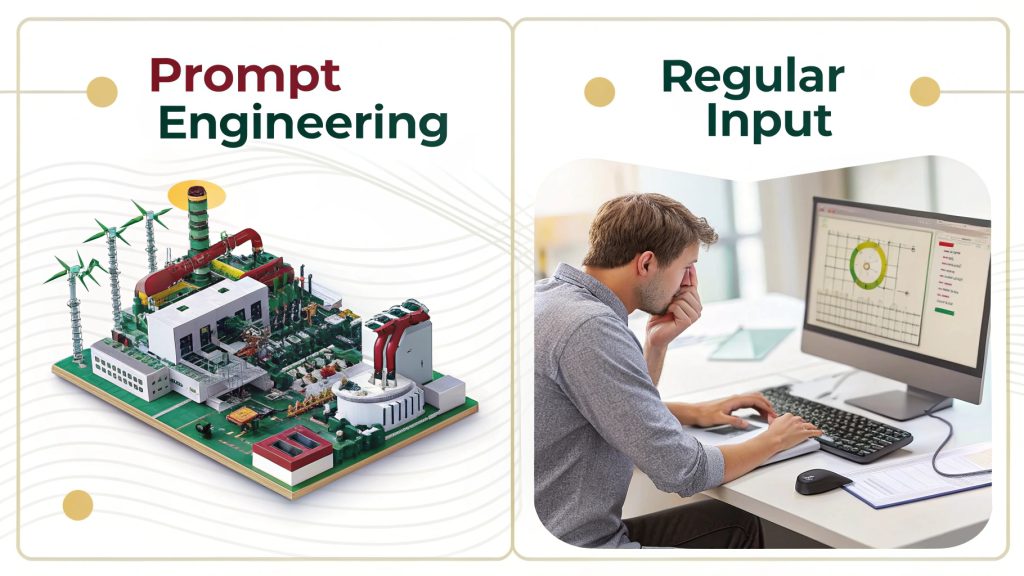See how prompt engineering outperforms basic input with real examples that show speed, clarity, and better AI results.
Not all AI prompts are created equal. While a basic request might get the job done, prompt engineering takes it to the next level — unlocking sharper, faster, and more useful results. In this article, we’ll compare prompt engineering to regular input using real examples to show how a few small tweaks can lead to massive gains in output quality.
Why This Comparison Matters
With the rise of AI tools in writing, design, coding, and research, there’s one factor that makes or breaks the results: your prompt. But not all prompts are created equal. This is where prompt engineering stands apart from regular input. Understanding the difference can save you time, boost accuracy, and unlock more creative potential. Let’s break it down with side-by-side examples.
What Is Regular Input?
Characteristics of a Basic Prompt
Regular input is typically short, vague, and lacking in direction. Users often assume the AI will “figure it out,” but in practice, this leads to generic results. These prompts usually skip important details like tone, structure, or audience. Think: “Write a blog post about coffee” or “Give me ideas for a product.”
Common Outcomes from Generic Requests
What you get from these prompts is often broad, flat, and requires heavy editing. While the AI will attempt to respond, it lacks focus and depth. You may spend more time revising than if you’d just written it yourself. This approach works for quick drafts but falls short when quality matters.
What Is Prompt Engineering?
Key Elements of an Engineered Prompt
Prompt engineering means crafting your input with purpose. It involves specifying roles, goals, format, tone, and audience. For example: “Act as a product copywriter. Write a 100-word product description for a premium stainless steel coffee mug, highlighting its eco-friendly features in a warm and inviting tone.”
Why It Yields Better Results
Engineered prompts give the AI structure. They reduce ambiguity and guide the output in a more human-like, goal-oriented way. This reduces the need for revisions and helps you get closer to your intended result on the first try. It also unlocks more advanced capabilities, like formatting, persuasion, or creative nuance.
Side-by-Side Examples: Prompt vs. Engineered
Example 1: Writing a Product Description
- Regular Input: Write a product description for a water bottle.
- Engineered Prompt: Act as a lifestyle copywriter. Write a 3-sentence product description for a BPA-free water bottle aimed at eco-conscious travelers, using friendly and adventurous language.
Result: The second version sounds like something you’d actually use on a sales page. It speaks to the audience and evokes a lifestyle, not just a feature list.
Example 2: Creating an AI Art Prompt
- Regular Input: Draw a sunset landscape.
- Engineered Prompt: Create a digital painting of a mountain landscape at sunset, with soft pink skies, glowing clouds, and a calm lake in the foreground. Impressionist style.
Result: The engineered prompt produces more vivid, emotionally resonant art. It communicates style, mood, and composition — all essential for quality visuals.
Example 3: Brainstorming Business Ideas
- Regular Input: Give me business ideas.
- Engineered Prompt: Act as a startup advisor. Suggest 5 low-cost business ideas for digital nomads that can be started with under $500. Focus on remote scalability.
Result: The refined prompt brings strategic relevance and targeted suggestions instead of a random mix of ideas.
The Time & Quality Efficiency Gap
Output Accuracy and Polish
Engineered prompts consistently produce cleaner, more relevant outputs. Because they give the AI context and constraints, the results require fewer edits. You get better grammar, tone, formatting, and alignment with your goal.
Time Saved with Fewer Revisions
While prompt engineering takes a few extra seconds upfront, it saves you minutes—or even hours—on the back end. Imagine writing a press release with one prompt instead of four rounds of trial and error. That’s real productivity.
When Is Prompt Engineering Most Useful?
High-Stakes Content or Client Work
If your output is going to a client, team, or public audience, prompt engineering is essential. It gives you more control over tone, accuracy, and impact. It’s the difference between a draft and a deliverable.
Creative and Strategic Outputs
Whether you’re writing ad copy, ideating a campaign, or generating product concepts, engineered prompts can guide the AI into smarter, more strategic territory. The result? More “wow” and less “meh.”
Final Thoughts: Small Tweaks, Big Results
Prompt engineering isn’t complicated — it’s intentional. Adding structure, tone, and context to your prompts gives you dramatically better results with the same tools. As AI becomes more integrated into daily work, learning to engineer your input may just become the most valuable skill you can build. Try it out. The difference is immediate.
Prompt engineering turns ordinary AI users into power users. Compared to basic input, it delivers better results with less back-and-forth, especially for content that matters. Start adding clarity, structure, and intent to your prompts — and you’ll see just how far your AI can go.

